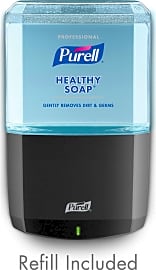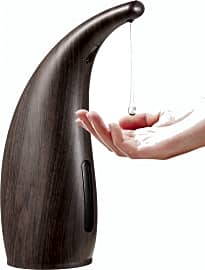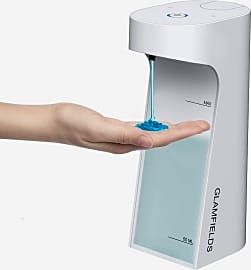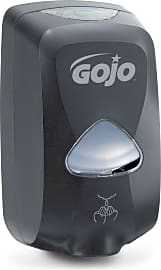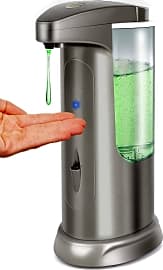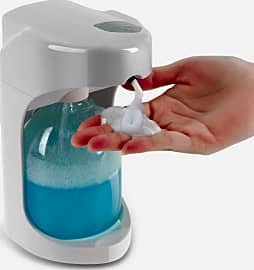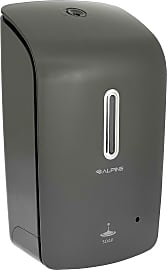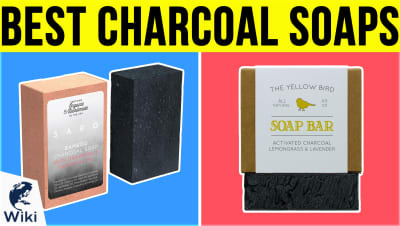The 10 Best Automatic Soap Dispensers

This wiki has been updated 33 times since it was first published in January of 2017. A hands-free soap dispenser is a smart way to promote hygiene in a home, office, or public restroom. Most of these options are not only technically advanced, but also quite affordable, meeting the budgets of most households and businesses. You can choose from liquid or foaming models, as well as wall-mounted or countertop ones – and don't forget to consider aesthetics. When users buy our independently chosen editorial picks, we may earn commissions to help fund the Wiki.
Editor's Notes
February 09, 2021:
During this update we removed the Lysol No-Touch as we don't feel it is durable enough for commercial use, nor attractive enough to place in the home. Instead, we have the Purell ES6 Kit, Alpine Wall Mountable 421, and Gojo TFX 2730-12 for high-volume commercial applications. We also eliminated the Wimaha Infrared due to availability issues. To add some versatility to our recommendations, we replaced the Simplehuman Sensor Pump with the Simplehuman ST1031, the former of which has a removable caddy to hold a sponge, scrubbing brush, or a couple of toothbrushes. Another new edition is the Paopow 300ml, which many people will appreciate for its eye-catching design that sets it apart from most others.
June 20, 2019:
Proper and frequent hand-washing is a way to prevent many types of illness. An automatic soap dispenser further helps to prevent the spread of germs since there’s no pump to touch. These devices are affordable, refillable, and can be mounted on a wall using some adhesive or a bracket.
Joining the mix is the Purell Fresh Scent Kit, which dispenses just the right amount of foam soap to help keep your hands germ free and smelling fresh. Its useful green LED flashes every few seconds to confirm that it’s operational. It comes with 1,200 milliliters of soap and the required four C batteries, so you’ll be in business right away. It’s equipped with both mounting hardware and adhesive tape, so you can install it whichever way you prefer.
From a company known for fighting germs, the Lysol No-Touch makes hand-washing a breeze and helps keep users healthy. It requires soap cartridges made by Lysol, which come in four pleasant fragrances: refreshing grapefruit essence, soothing cucumber splash, aloe vera, and Vitamin E with moisturizers. It operates both quietly and reliably. While it doesn’t come with the soap, it does include the three required AA batteries.
For another choice that that receives high marks, look to the Secura Premium Touchless, which can hold up to 17 ounces of liquid, so it likely can go without refilling for quite a while. It has a volume control dial and a handy on-off switch, and the rear battery compartment helps to keep the batteries free from moisture. It features keyholes on the back for easy wall mounting.
A More Hygienic Bathroom
There, the water turns on by itself to the perfect temperature, you place your hands briefly under an automatic soap dispenser, and commence washing.
The bathroom can be an awfully scary place. While it's designed to essentially take a person and make them cleaner, there is a host of hygienic pitfalls in a given bathroom. One of the most dangerous issues in home bathrooms is something called the toilet plume, which is essentially a spray of particles, mostly a mix of toilet water, urine, and fecal matter — combined with any bacterial elements in your bowl — that shoots up and lands pretty much anywhere it wants. If your throne isn't cordoned off from your sink area, your tub, or wherever you hang your bath towels, there's a good chance all of those spots are at risk.
One of the last things we interact with in any bathroom is also one of the most dangerous: your hand towel. Most people leave their hand towels in place for far too long, and with each consecutive use, they absorb and retain more and more moisture. That, combined with the fact that most people don't wash their hands properly enough after using the latrine, creates an incredible breeding ground for some of the most heinous bacteria imaginable.
It is possible to imagine a more hygienic bathroom, however. Ideally, it would start with removing the toilet from its current position and locating it somewhere farther from the sink, the tub, and those other danger zones we've already covered. For most folks, that kind of remodeling is unfeasible, but that doesn't mean there aren't additional steps you can take to ensure a more hygienic experience.
Imagine, if you will, a fully automated bathroom. You go in, and the lights turn on by themselves. A sensor raises the lid on the bowl, and another can be activated to raise and lower the seat. You sit down, do your business, and an automatic bidet takes care of the majority of your clean up. You stand, the seat and lid lower themselves as the unit automatically flushes, and you head to the sink. There, the water turns on by itself to the perfect temperature, you place your hands briefly under an automatic soap dispenser, and commence washing. At this point, things go off the rails just a little, as the science behind weather a forced air hand dryer is hygienic or not is rather combative. If you keep your hand towel hung at a safe distance from your toilet, however, and you change it regularly, it can be the one and only thing that you have to touch other than the button on your pants.
It might take time for some of these innovations to become widely available on the market, but things like hands-free soap dispensers are available right now, and they offer you one more step in the direction of a more hygienic bathroom. They are easy to install, easy to use, and they are indispensable once you see what they can do.
Choosing Your Soap Dispenser
Choosing an automatic soap dispenser will likely have more to do with the bathroom in which you plan to install it than anything else. Odds are, if you're seriously perusing this list, you fall into one of two camps. You're either a homeowner looking to increase the level of hygiene in your bathroom or you're a business person who's shop has a public restroom that you want to stay as clean and hygienic as possible.
A visitor coming into your home isn't likely to walk away with your soap dispenser as readily as a stranger who just bought something from you and needed to use the restroom.
If you're a business owner, you'll have a certain set of features that are more important to you than they would be to homeowners. Installation, for example, is going to be a lot different in your public restroom then it would be in someone's home. Sure, you can always get a simple sink-top model like the ones intended for home use and place it wherever you like in your public restroom, but the real danger here is theft. A visitor coming into your home isn't likely to walk away with your soap dispenser as readily as a stranger who just bought something from you and needed to use the restroom.
Business owners will also want to keep an eye on the capacity of a given model. The fewer times you have to refill your soap dispenser throughout the day, the better. That will allow you to focus on every other aspect of your business, and you can relegate that activity to whatever your regular bathroom maintenance schedule is.
For homeowners looking to add a bit of hygiene to their bathrooms, an automatic soap dispenser’s first duty is to look good. Bathroom design is as important as the design of any other room, and perhaps more so for the degree of relaxation that certain activities in the bathroom require. The color scheme, style, and overall organization of the bathroom will all lend themselves to a more enjoyable experience. Homeowners will also want as much capacity as possible, if only to reduce the amount of hassle that refilling the dispenser can cause, but this consideration generally takes a backseat to style.
A Brief History Of Soap
Human beings spent the majority of their existence without the help of soap. Presumably, most methods for getting clean, if getting clean was even a registered desire among our ancestors, involved little more then jumping in a body of water. It wasn't until the year 2200 B.C.E. that we find evidence of soap not too dissimilar to the kinds of soap we use today. That evidence is a recipe for soap scrawled on an ancient Babylonian tablet, and it includes oil, alkali, and water.
It wasn't until the year 2200 B.C.E. that we find evidence of soap not too dissimilar to the kinds of soap we use today.
The ancient Egyptians had a formula for soap of their own, as did the ancient Romans, but the Chinese from parallel eras were working with something quite different. While many such developments in Egypt and eventually Italy had reasonable analogs in Far Eastern cultures, the Chinese wouldn't adopt a recipe similar to Western soaps until many centuries later.
Despite Americans' belief that they don't use the stuff enough, the French actually spearheaded the industrial manufacturing of soap prior to the Industrial Revolution. Eventually, industrial methods became so efficient that bar soap became a mainstay in the vast majority of homes. Liquid soap finally hit the scene in the middle of the 19th century, and today, you’ll find it in just about every kitchen and bathroom in the developed world.



